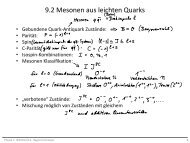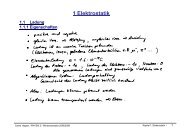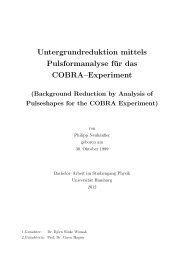Setup of a Drift Tube Muon Tracker and Calibration of Muon ...
Setup of a Drift Tube Muon Tracker and Calibration of Muon ...
Setup of a Drift Tube Muon Tracker and Calibration of Muon ...
You also want an ePaper? Increase the reach of your titles
YUMPU automatically turns print PDFs into web optimized ePapers that Google loves.
Figure 4.11: Light yield spectrum for the positron prompt events <strong>of</strong> the ¯ν e c<strong>and</strong>idatesobserved in Borexino. Figure taken from [50]. The dotted red line shows the fit forthe geo-neutrino contribution.the 7 Be neutrinos <strong>of</strong> 0.862 MeV <strong>and</strong> the lower threshold <strong>of</strong> the 8 B measurements<strong>of</strong> 3 MeV has not yet been thoroughly investigated. This is exactly the region atwhich the transition between vacuum <strong>and</strong> matter dominated oscillations occurs.pep neutrinos are mono-energetic with an energy <strong>of</strong> 1.442 MeV. CNO neutrinos canreach energies up to 1.732 MeV. The observation <strong>of</strong> pep <strong>and</strong> CNO neutrinos couldthus be used to probe this region.The CNO neutrino flux is still one <strong>of</strong> the major uncertainties in the st<strong>and</strong>ardsolar models. Measuring it would allow to improve the predictions for the Sun’smetallicity Z. Like the 7 Be neutrinos, pep neutrinos could be easily identified bya Compton-like edge in the energy spectrum. Their flux is directly correlated tothe pp neutrino flux. Measuring the pep neutrino flux would thus allow to drawconclusions on the fundamental pp fusion reaction. Besides the impact on soalrphysics, measuring the CNO neutrino flux also allows for testing the intemediateenergy regime <strong>of</strong> the transition region <strong>of</strong> the MSW effect.The combined flux <strong>of</strong> pep <strong>and</strong> CNO neutrinos is predicted to be <strong>of</strong> the order<strong>of</strong> 7 × 10 8 cm −2 s −1 , almost one order <strong>of</strong> magnitude below the lower energetic 7 Beneutrino flux but more than one order <strong>of</strong> magnitude above the higher energetic8 B neutrino flux. Neutrinos from these two sources have already successfully beendetected, hence it should also be possible to observe pep <strong>and</strong> CNO neutrinos. Unfortunately,the energy region <strong>of</strong> interest is dominated by the uncorrelated 11 C cosmogenicbackground, caused by cosmic muons passing the detector. The expected rate<strong>of</strong> 11 C events in Borexino is expected to be approximately five times higher than theneutrino signal. It is thus utterly important to find a way to sufficiently suppressthis background. It has been shown in Section 4.3.3 that the three fold coincidenceis used for this task. It relies on a precise muon tracking to avoid excluding largevolumes from the fiducial value. The CMT can perform this kind <strong>of</strong> measurement,however, the detector is not capable to cover all <strong>of</strong> Borexino. Nevertheless it can beused to improve the 11 C tagging. By comparing results <strong>of</strong> tracks reconstructed by67





